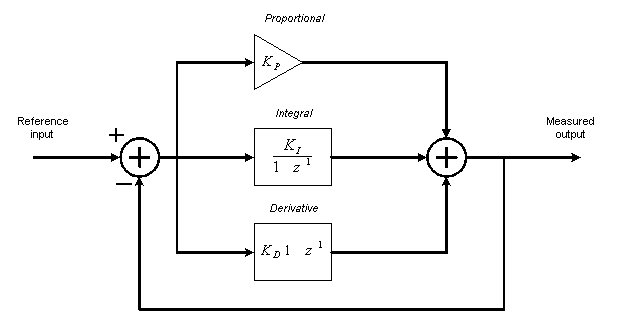|
CMSIS2000
0.0.7
|
|
CMSIS2000
0.0.7
|
A Proportional Integral Derivative (PID) controller is a generic feedback control loop mechanism widely used in industrial control systems. Подробнее...

|
Функции | |
| __STATIC_INLINE float32_t | arm_pid_f32 (arm_pid_instance_f32 *S, float32_t in) |
| Process function for the floating-point PID Control. | |
| __STATIC_INLINE q15_t | arm_pid_q15 (arm_pid_instance_q15 *S, q15_t in) |
| Process function for the Q15 PID Control. | |
| __STATIC_INLINE q31_t | arm_pid_q31 (arm_pid_instance_q31 *S, q31_t in) |
| Process function for the Q31 PID Control. | |
A Proportional Integral Derivative (PID) controller is a generic feedback control loop mechanism widely used in industrial control systems.
A PID controller is the most commonly used type of feedback controller.
This set of functions implements (PID) controllers for Q15, Q31, and floating-point data types. The functions operate on a single sample of data and each call to the function returns a single processed value. S points to an instance of the PID control data structure. in is the input sample value. The functions return the output value.
y[n] = y[n-1] + A0 * x[n] + A1 * x[n-1] + A2 * x[n-2] A0 = Kp + Ki + Kd A1 = (-Kp ) - (2 * Kd ) A2 = Kd
Kp is proportional constant, Ki is Integral constant and Kd is Derivative constant
| __STATIC_INLINE float32_t arm_pid_f32 | ( | arm_pid_instance_f32 * | S, |
| float32_t | in | ||
| ) |
Process function for the floating-point PID Control.
| [in,out] | *S | is an instance of the floating-point PID Control structure |
| [in] | in | input sample to process |
См. определение в файле arm_math.h строка 5202
Перекрестные ссылки arm_pid_instance_f32::A0, arm_pid_instance_f32::A1, arm_pid_instance_f32::A2 и arm_pid_instance_f32::state.
| __STATIC_INLINE q15_t arm_pid_q15 | ( | arm_pid_instance_q15 * | S, |
| q15_t | in | ||
| ) |
Process function for the Q15 PID Control.
| [in,out] | *S | points to an instance of the Q15 PID Control structure |
| [in] | in | input sample to process |
Scaling and Overflow Behavior:
См. определение в файле arm_math.h строка 5285
Перекрестные ссылки __SIMD32, arm_pid_instance_q15::A0, arm_pid_instance_q15::A1 и arm_pid_instance_q15::state.
| __STATIC_INLINE q31_t arm_pid_q31 | ( | arm_pid_instance_q31 * | S, |
| q31_t | in | ||
| ) |
Process function for the Q31 PID Control.
| [in,out] | *S | points to an instance of the Q31 PID Control structure |
| [in] | in | input sample to process |
Scaling and Overflow Behavior:
См. определение в файле arm_math.h строка 5237
Перекрестные ссылки arm_pid_instance_q31::A0, arm_pid_instance_q31::A1, arm_pid_instance_q31::A2 и arm_pid_instance_q31::state.